电气工程及其自动化专业英语翻译中国电力出版社苏小林56页PPT
- 格式:ppt
- 大小:7.60 MB
- 文档页数:56
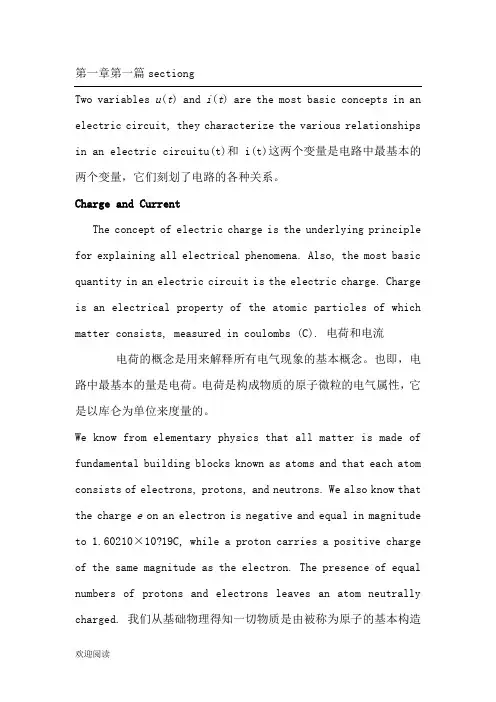
第一章第一篇sectiongTwo variables u(t) and i(t) are the most basic concepts in an electric circuit, they characterize the various relationships in an electric circuitu(t)和i(t)这两个变量是电路中最基本的两个变量,它们刻划了电路的各种关系。
the charge e on an electron is negative and equal in magnitude to 1.60210×10 19C, while a proton carries a positive charge of the same magnitude as the electron. The presence of equal numbers of protons and electrons leaves an atom neutrally charged. 我们从基础物理得知一切物质是由被称为原子的基本构造部分组成的,并且每个原子是由电子,质子和中子组成的。
我们还知道电子的电量是负的并且在数值上等于 1.602100×10-12C,而质子所带的正电量在数值上与电子相等。
质子和电子数量相同使得原子呈现电中性。
We consider the flow of electric charges. A unique feature offlow of negative charges, as Fig.l-1 illustrates. This convention was introduced by Benjamin Franklin (l706~l790), the American scientist and inventor. Although we now know that current in metallic conductors is due to negatively charged electrons, we will follow the universally accepted conventionthat current is the net flow of positive charges. Thus, Electriccurrent is the time rate of charge, measured in amperes (A).Mathematically, the relationship among current i , charge q , andtime t is 当我们把一根导线连接到某一电池上时(一种电动势源),电荷被外力驱使移动;正电荷朝一个方向移动而负电荷朝相反的方向time in several ways that may be represented by different kindsof mathematical functions 我们通过方程(1-1)定义电流的方式表明电流不必是一个恒值函数,电荷可以不同的方式随时间而变化,这些不同的方式可用各种数学函数表达出来。

电气工程及其自动化专业英语翻译.Electric Power Systems.The modern society depends on the electricity supply more heavily thanever before. It can not be imagined what the world should be if the electricity supply were interrupted all over the world. Electric power systems (or electric energy systems), providing electricity to the modern society, have become indispensable components of the industrial world. The first complete electric power system (comprising a generator, cable, fuse, meter, and loads) was built by Thomas Edison –the historic Pearl Street Station in New York City which began operation in September 1882. This was a DC system consisting of a steam-engine-driven DC generator supplying power to 59 customers within an area roughly 1.5 km in radius. The load, which consisted entirely of incandescent lamps, was suppliedat 110 V through an underground cable system.. Within a few years similar systems were in operation in most large cities throughout the world. Withthe development of motors by Frank Sprague in 1884, motor loads were addedto such systems. This was the beginning of what would develop into oneof the largest industries in the world. In spite of the initial widespreaduse of DC systems, they were almost completely superseded by AC systems. By 1886, the limitations of DC systems were becoming increasingly apparent. They could deliver power only a short distance from generators. To keep transmission power losses ( I 2 R ) and voltage drops to acceptable levels, voltage levels had to be high for long-distance power transmission. Such high voltages were not acceptable for generation and consumption of power; therefore, a convenient means for voltage transformation became a necessity.The development of the transformer and AC transmission by L. Gaulard and JD Gibbs of Paris, France, led to AC electric power systems. In 1889, the first AC transmission line in North America was put into operation in Oregon between Willamette Falls and Portland. It was a single-phase line transmitting power at 4,000 V overa distance of 21 km. With the development of polyphase systems by Nikola Tesla, the AC system became even more attractive. By 1888, Tesla held several patents on AC motors, generators, transformers, and transmission systems. Westinghouse bought the patents to these early inventions, and they formed the basis of the present-day AC systems. In the 1890s, there was considerable controversy over whether the electric utility industry should be standardized on DC or AC. By the turn of the century, the AC system had won out over the DC system for the following reasons:(1)V oltage levels can be easily transformed in AC systems, thus providing the flexibility for use of different voltages forgeneration, transmission, and consumption.(2)AC generators are much simpler than DC generators.(3)AC motors are much simpler and cheaper than DC motors.The first three-phase line in North America went into operation in 1893.——a 2,300 V, 12 km line in southern California. In the early periodof AC power transmission, frequency was not standardized. This poses a problem for interconnection. Eventually 60 Hz was adopted as standardin North America, although 50 Hz was used in many other countries. The increasing need for transmitting large amounts of power over longer distance created an incentive to use progressively high voltage levels.To avoid the proliferation of an unlimited number of voltages, theindustry has standardized voltage levels. In USA, the standards are 115, 138, 161, and 230 kV for the high voltage (HV) class, and 345, 500 and 765 kV for the extra-high voltage (EHV) class. In China, the voltage levels in use are 10, 35, 110 for HV class, and 220, 330 (only in Northwest China) and 500 kV for EHV class . The first 750 kVtransmission line will be built in the near future in Northwest China. With the development of the AC/DC converting equipment, high voltage DC (HVDC) transmission systems have become more attractive and economical in special situations. The HVDC transmission can be used for transmissionof large blocks of power over long distance, and providing an asynchronouslink between systems where AC interconnection would be impracticalbecause of system stability consideration or because nominal frequenciesof the systems are different. The basic requirement to a power systemis to provide an uninterrupted energy supply to customers with acceptablevoltages and frequency. Because electricity can not be massively storedunder a simple and economic way, the production and consumption ofelectricity must be done simultaneously. A fault or misoperation in anystages of a power system may possibly result in interruption ofelectricity supply to the customers. Therefore, a normal continuousoperation of the power system to provide a reliable power supply to the customers is of paramount importance. Power system stability may bebroadly defined as the property of a power system that enables it to remainin a state of operating equilibrium under normal operating conditionsand to regain an acceptable state of equilibrium after being subjectedto a disturbance.. Instability in a power system may be manifested inmany different ways depending on the system configuration and operatingmode. Traditionally, the stability problem has been one of maintaining synchronous operation. Since power systems rely on synchronous machinesfor generation of electrical power, a necessary condition forsatisfactory system operation is that all synchronous machines remainin synchronism or, colloquially in step. This aspect of stability isinfluenced by the dynamics of generator rotor angles and power-angle relationships, and then referred to rotor angle stability译文:电力系统现代社会比以往任何时候更多地依赖于电力供应。
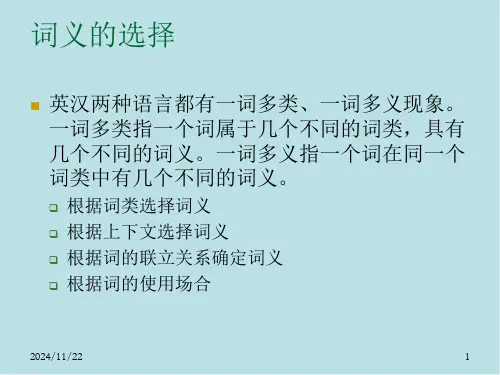
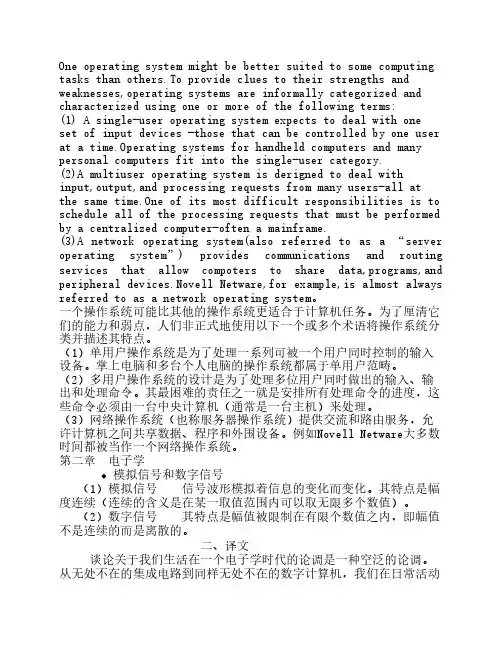
One operating system might be better suited to some computing tasks than others.To provide clues to their strengths and weaknesses,operating systems are informally categorized and characterized using one or more of the following terms:(1) A single-user operating system expects to deal with oneset of input devices -those that can be controlled by one user at a time.Operating systems for handheld computers and many personal computers fit into the single-user category.(2)A multiuser operating system is derigned to deal with input,output,and processing requests from many users-all atthe same time.One of its most difficult responsibilities is to schedule all of the processing requests that must be performed by a centralized computer-often a mainframe.(3)A network operating system(also referred to as a “server operating system”) provides communications and routing services that allow compoters to share data,programs,and peripheral devices.Novell Netware,for example,is almost always referred to as a network operating system。
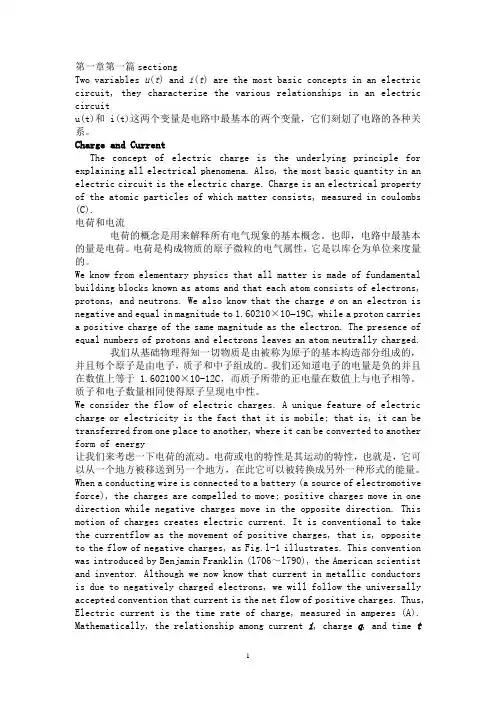
第一章第一篇sectiongTwo variables u(t) and i(t) are the most basic concepts in an electric circuit, they characterize the various relationships in an electric circuitu(t)和i(t)这两个变量是电路中最基本的两个变量,它们刻划了电路的各种关系。
Charge and CurrentThe concept of electric charge is the underlying principle for explaining all electrical phenomena. Also, the most basic quantity in an electric circuit is the electric charge. Charge is an electrical property of the atomic particles of which matter consists, measured in coulombs (C).电荷和电流电荷的概念是用来解释所有电气现象的基本概念。
也即,电路中最基本的量是电荷。
电荷是构成物质的原子微粒的电气属性,它是以库仑为单位来度量的。
We know from elementary physics that all matter is made of fundamental building blocks known as atoms and that each atom consists of electrons, protons, and neutrons. We also know that the charge e on an electron is negative and equal in magnitude to 1.60210×10 19C, while a proton carries a positive charge of the same magnitude as the electron. The presence of equal numbers of protons and electrons leaves an atom neutrally charged.我们从基础物理得知一切物质是由被称为原子的基本构造部分组成的,并且每个原子是由电子,质子和中子组成的。


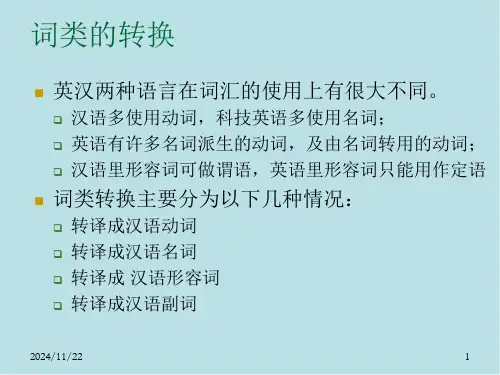
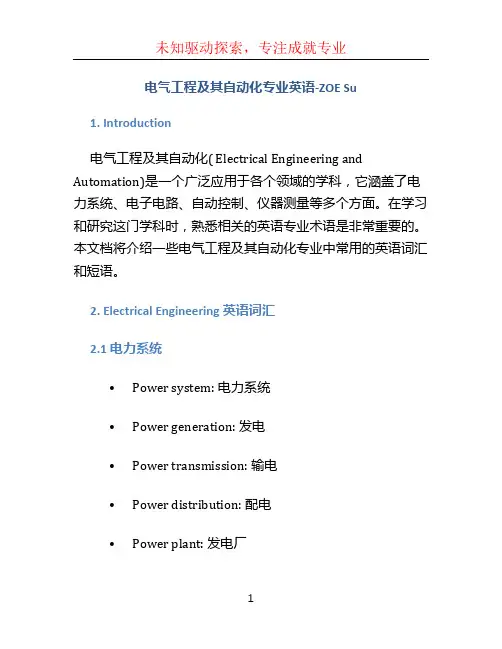
电气工程及其自动化专业英语-ZOE Su1. Introduction电气工程及其自动化( Electrical Engineering and Automation)是一个广泛应用于各个领域的学科,它涵盖了电力系统、电子电路、自动控制、仪器测量等多个方面。
在学习和研究这门学科时,熟悉相关的英语专业术语是非常重要的。
本文档将介绍一些电气工程及其自动化专业中常用的英语词汇和短语。
2. Electrical Engineering 英语词汇2.1 电力系统•Power system: 电力系统•Power generation: 发电•Power transmission: 输电•Power distribution: 配电•Power plant: 发电厂•Substation: 变电站•Transformer: 变压器•Generator: 发电机•Transmission line: 输电线路•Circuit breaker: 断路器•Load: 负载2.2 电子电路•Circuit: 电路•Resistor: 电阻器•Capacitor: 电容器•Inductor: 电感器•Diode: 二极管•Transistor: 晶体管•Integrated circuit (IC): 集成电路•Printed circuit board (PCB): 印制电路板•Voltage: 电压•Current: 电流2.3 自动控制•Control system: 控制系统•Feedback: 反馈•PID controller: 比例积分微分(PID)控制器•Sensor: 传感器•Actuator: 执行器•Control signal: 控制信号•Closed-loop control: 闭环控制•Open-loop control: 开环控制2.4 仪器测量•Instrumentation: 仪器测量•Measurement: 测量•Accuracy: 精度•Calibration: 校准•Sensor: 传感器•Meter: 仪表•Voltmeter: 电压计•Ammeter: 电流计•Oscilloscope: 示波器•Multimeter: 电表3. Electrical Engineering 英语短语3.1 电力系统•Power blackout: 停电•Grid integration: 网络集成•Load shedding: 负荷调节•Power factor: 功率因数•Power outage: 断电•Voltage regulation: 电压调节•Renewable energy: 可再生能源•Power factor correction: 功率因数校正•Power supply: 电源3.2 电子电路•Logic gate: 逻辑门•Circuit design: 电路设计•Printed circuit board (PCB) design: 印刷电路板设计•Analog circuit: 模拟电路•Digital circuit: 数字电路•Circuit analysis: 电路分析•Circuit simulation: 电路仿真•Circuit board layout: 电路板布局•Electronic component: 电子元件•Circuit diagram: 电路图3.3 自动控制•Automatic control: 自动控制•Control loop: 控制回路•Feedback loop: 反馈回路•Control system design: 控制系统设计•Proportional control: 比例控制•Integral control: 积分控制•Derivative control: 微分控制•Control algorithm: 控制算法•System response: 系统响应•Setpoint: 设定值3.4 仪器测量•Measurement uncertainty: 测量不确定性•Precision measurement: 精密测量•Measurement accuracy: 测量准确性•Metrology: 计量学•Calibration procedure: 校准程序•Test equipment: 测试设备•Instrument calibration: 仪器校准•Measurement range: 测量范围•Measurement error: 测量误差•Data acquisition: 数据采集4. 总结掌握电气工程及其自动化专业中的英语词汇和短语是很有必要的,它可以帮助我们更好地理解和交流相关知识。
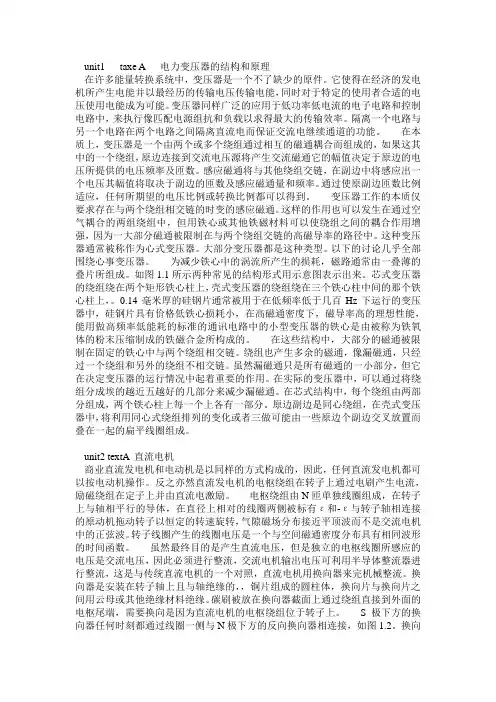
unit1 taxe A 电力变压器的结构和原理在许多能量转换系统中,变压器是一个不了缺少的原件。
它使得在经济的发电机所产生电能并以最经历的传输电压传输电能,同时对于特定的使用者合适的电压使用电能成为可能。
变压器同样广泛的应用于低功率低电流的电子电路和控制电路中,来执行像匹配电源组抗和负载以求得最大的传输效率。
隔离一个电路与另一个电路在两个电路之间隔离直流电而保证交流电继续通道的功能。
在本质上,变压器是一个由两个或多个绕组通过相互的磁通耦合而组成的,如果这其中的一个绕组,原边连接到交流电压源将产生交流磁通它的幅值决定于原边的电压所提供的电压频率及匝数。
感应磁通将与其他绕组交链,在副边中将感应出一个电压其幅值将取决于副边的匝数及感应磁通量和频率。
通过使原副边匝数比例适应,任何所期望的电压比例或转换比例都可以得到。
变压器工作的本质仅要求存在与两个绕组相交链的时变的感应磁通。
这样的作用也可以发生在通过空气耦合的两组绕组中,但用铁心或其他铁磁材料可以使绕组之间的耦合作用增强,因为一大部分磁通被限制在与两个绕组交链的高磁导率的路径中。
这种变压器通常被称作为心式变压器。
大部分变压器都是这种类型。
以下的讨论几乎全部围绕心事变压器。
为减少铁心中的涡流所产生的损耗,磁路通常由一叠薄的叠片所组成。
如图1.1所示两种常见的结构形式用示意图表示出来。
芯式变压器的绕组绕在两个矩形铁心柱上,壳式变压器的绕组绕在三个铁心柱中间的那个铁心柱上,。
0.14毫米厚的硅钢片通常被用于在低频率低于几百Hz下运行的变压器中,硅钢片具有价格低铁心损耗小,在高磁通密度下,磁导率高的理想性能,能用做高频率低能耗的标准的通讯电路中的小型变压器的铁心是由被称为铁氧体的粉末压缩制成的铁磁合金所构成的。
在这些结构中,大部分的磁通被限制在固定的铁心中与两个绕组相交链。
绕组也产生多余的磁通,像漏磁通,只经过一个绕组和另外的绕组不相交链。
虽然漏磁通只是所有磁通的一小部分,但它在决定变压器的运行情况中起着重要的作用。
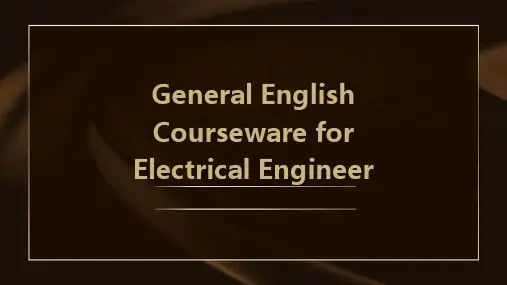
第一章第一篇sectiongTwo variables u(t) and i(t) are the most basic concepts in an electric circuit, they characterize the various relationships in an electric circuitu(t)和i(t)这两个变量是电路中最基本的两个变量,它们刻划了电路的各种关系。
Charge and CurrentThe concept of electric charge is the underlying principle for explaining all electrical phenomena. Also, the most basic quantity in an electric circuit is the electric charge. Charge is an electrical property of the atomic particles of which matter consists, measured in coulombs (C).电荷和电流电荷的概念是用来解释所有电气现象的基本概念。
也即,电路中最基本的量是电荷。
电荷是构成物质的原子微粒的电气属性,它是以库仑为单位来度量的。
We know from elementary physics that all matter is made of fundamental building blocks known as atoms and that each atom consists of electrons, protons, and neutrons. We also know that the charge e on an electron is negative and equal in magnitude to 1.60210×10 19C, while a proton carries a positive charge of the same magnitude as the electron. The presence of equal numbers of protons and electrons leaves an atom neutrally charged.我们从基础物理得知一切物质是由被称为原子的基本构造部分组成的,并且每个原子是由电子,质子和中子组成的。